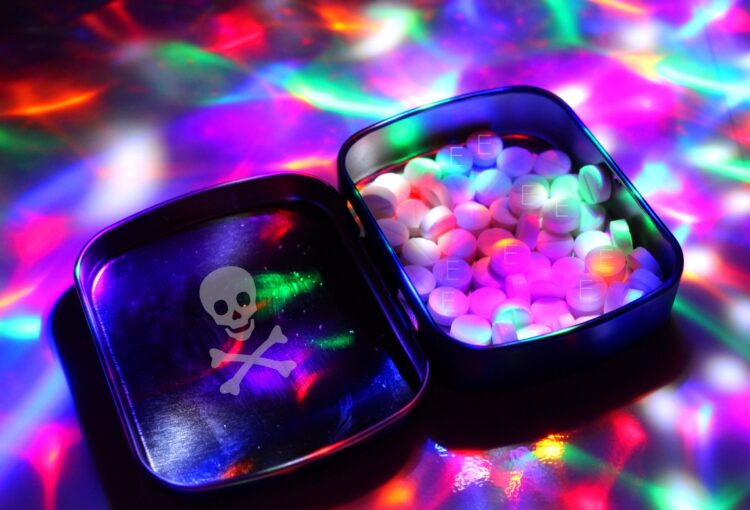Many young people and teens believe a little experimentation with drugs or alcohol isn’t a big deal, especially when they’re trying to have a good time with their friends. However, ecstasy requires a closer look, as it can have serious health consequences. Fortunately, effective ecstasy withdrawal and treatment is possible when managed by addiction professionals.
What You Should Know About Ecstasy
Ecstasy, also known as MDMA (an abbreviation of 3,4-methylenedioxymethamphetamine) is an easily obtainable illegal substance people use to experience more enhanced sensations while at dance parties or “raves”, clubs, and concerts. It’s referred to as a “designer drug” because it’s a synthetic product not derived from a plant but manufactured in a laboratory, often including additives such as bath salts, caffeine, cut amphetamines, PCP, and sometimes cocaine or crack.
As both a stimulant and a hallucinogenic, ecstasy amplifies emotions, touch, sight, and sound. People often have an increased desire to touch or be touched, so sometimes it’s called “the love pill” as a result. These intense reactions, which last 3–6 hours, frequently cause someone to develop a strong dependence on ecstasy, but it also causes negative experiences, especially when mixed with alcohol or marijuana.
The U.S. Drug Enforcement Administration (DEA) lists ecstasy as a Schedule 1 substance, which means it has a “a high potential for abuse, no currently accepted medical use in treatment in the United States, and a lack of accepted safety for use under medical supervision.” Ecstasy has numerous street names, including 007, Adam, Beans, Disco biscuit, E, Eve, Hug Drug, Lover’s Speed, Molly, Peace, X, and XTC.
It’s manufactured in various doses of capsules, dissolving tab form, pills, and tablets. People swallow, crush, or snort this drug, and sometimes employ:
- “Stacking.” by taking three or more doses at once,
- “Piggy-backing,” by repeating doses over a short time period, or;
- “Candy-flipping,” which is combining ecstasy with LSD.
The Foundation for a Drug-Free World shares this anecdote from a young user: “Rave parties are okay so long as you don’t take ecstasy. But as soon as you start, you think people who advise you to stop are idiots. You start to believe you have found something great and others must not try to tell you the contrary. When you start liking ecstasy, it’s too late, you’re sunk.”
The National Institute on Drug Abuse reports that in 2020, nearly 10 percent of teens in 8th, 10th, and 12th grades indicated they used ecstasy in their lifetime.
Side Effects of Ecstasy or Molly
Taking ecstasy alters serotonin, a brain chemical responsible for regulating aggression, mood, pain sensitivity, sexual arousal, and sleep habits. The DEA indicates that the euphoric state often produced by chronic use of this drug may actually permanently damage the brain’s ability to feel pleasure naturally or reduce it altogether.
Common side effects include:
- Anxiety
- Blurred vision
- Chills
- Confusion
- Dehydration
- Dizziness or fainting
- Irritability
- Muscle cramps and tension
- Sweating
- Teeth clenching
More serious side effects include, but aren’t limited to:
- Cravings
- Depression
- Excessive dehydration
- Hallucinations
- Hyperthermia
- Panic attacks
- Paranoia
- Sleep problems
In addition to serotonin disruption, the DEA notes that “clinical studies suggest that MDMA may increase the risk of long-term, perhaps permanent, problems with memory and learning.” An ecstasy overdose, especially combined with hyperthermia, might cause heart, liver, or kidney problems, or possibly death.
Symptoms of Ecstasy Addiction and the Need for Treatment
The intensity of withdrawal from any drug is always dependent on the amount used and for how long, and this formula is no different for Molly. But if someone needs help, fear of ecstasy withdrawal symptoms shouldn’t be a reason to avoid professional treatment.
According to Healthline, it often takes two days for the body to process and eliminate the drug. During this time, some people feel some of the more severe side effects listed above, along with fatigue and a loss of appetite. But current research is unclear about how addictive ecstasy might be, especially when combined with other substances.
If you notice the following symptoms, talk to a healthcare provider or addiction specialist right away:
- A lack of ability or desire to perform daily routines, including going to school or work
- Extreme behavioral or personality changes
- Cravings for ecstasy, even when it has a negative impact on well-being
- Being more withdrawn or depressed
Trust the Professionals at Willingway
Communicating with your teen about ecstasy or other drug use may seem difficult at first, but it’s an important first step to ensure their health and the promise of a better future. At Willingway, we embrace the importance of family and its role in addiction recovery, which is why we developed a teen addiction rehabilitation center, The Pines at Willingway.
This residential treatment center draws on 50 years of experience in progressive, evidence-based treatment, and specializes in detoxification, residential treatment, and partial hospitalization services for teens dealing with a substance use problem. Along with the principles of 12-step guidance, each resident’s individualized treatment plan is rooted in The Hazelden Matrix for adolescent substance abuse treatment, which incorporates individual, group, and family therapy; early recovery skills; family education; social support; and relapse prevention.

